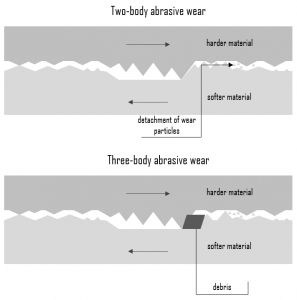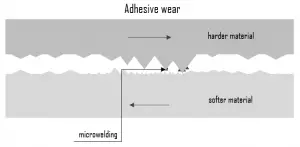In general, wear is mechanically induced surface damage that results in the progressive removal of material due to relative motion between that surface and a contacting substance or substances. A contacting substance may consist of another surface, a fluid, or hard, abrasive particles contained in some form of fluid or suspension, such as a lubricant for example. As is with friction, the presence of wear can be either good or bad. Productive, controlled wear can be found in processes like machining, cutting, grinding and polishing. However, in most of the technological applications, the occurrence of wear is highly undesirable and it is an enormously expensive problem since it leads to the deterioration or even failure of components. In terms of safety it is often not as serious (or as sudden) as fracture. This is because wear is usually anticipated.
Certain material characteristics such as hardness, carbide type, and volume percent can have a decided impact on the wear resistance of a material in a given application. Wear, like corrosion, has multiple types and subtypes, is predictable to some extent, and is rather difficult to reliably test and to evaluate in the lab or in service.
Abrasive Wear
 Abrasive wear is defined as the loss of material due to hard particles or hard protuberances that are forced against and move along a solid surface. It occurs when a hard rough surface slides across a softer surface. This mechanism is sometimes referred to as grinding wear. The harder material may be one of the rubbing surfaces or hard particles that have found their way between the mating surfaces. These may be ‘foreign’ particles or particles resulting from adhesive or delamination wear. Abrasion mainly involves microscale cutting and plowing processes. The way an asperity slides over a surface determines the nature and intensity of abrasive wear. There are two basic modes of abrasive wear:
Abrasive wear is defined as the loss of material due to hard particles or hard protuberances that are forced against and move along a solid surface. It occurs when a hard rough surface slides across a softer surface. This mechanism is sometimes referred to as grinding wear. The harder material may be one of the rubbing surfaces or hard particles that have found their way between the mating surfaces. These may be ‘foreign’ particles or particles resulting from adhesive or delamination wear. Abrasion mainly involves microscale cutting and plowing processes. The way an asperity slides over a surface determines the nature and intensity of abrasive wear. There are two basic modes of abrasive wear:
- Two-body abrasive wear. Two-body wear occurs when the grits or hard particles remove material from the opposite surface. The common analogy is that of material being removed or displaced by a cutting or plowing operation.
- Three-body abrasive wear. Three-body wear occurs when the particles are not constrained, and are free to roll and slide down a surface. The contact environment determines whether the wear is classified as open or closed. An open contact environment occurs when the surfaces are sufficiently displaced to be independent of one another.
There are a number of different strategies for mitigating abrasive wear, but the general rule for materials selection is, the harder the better. Materials that contain a relatively large percentage of hard, wear-resistant alloy carbides, such as selected tool steels and high-speed steels.
Adhesive Wear
 Adhesive wear is originated through the bonding of asperities or microscopic high points (surface roughness) between two sliding materials. When a peak from one surface comes into contact with a peak from the other surface, instantaneous microwelding may take place due to the heat generated by the resulting friction. This results in detachment or material transfer from one surface to the other. For adhesive wear to occur it is necessary for the surfaces to be in intimate contact with each other. This may cause unwanted displacement and attachment of wear debris and material compounds from one surface to another. Adhesive wear can lead to an increase in roughness and the creation of protrusions (i.e., lumps) above the original surface. Surfaces which are held apart by lubricating films, oxide films etc. reduce the tendency for adhesion to occur. In some engineering applications, surfaces slide in air or without lubricant and the resulting wear is termed as dry sliding.
Adhesive wear is originated through the bonding of asperities or microscopic high points (surface roughness) between two sliding materials. When a peak from one surface comes into contact with a peak from the other surface, instantaneous microwelding may take place due to the heat generated by the resulting friction. This results in detachment or material transfer from one surface to the other. For adhesive wear to occur it is necessary for the surfaces to be in intimate contact with each other. This may cause unwanted displacement and attachment of wear debris and material compounds from one surface to another. Adhesive wear can lead to an increase in roughness and the creation of protrusions (i.e., lumps) above the original surface. Surfaces which are held apart by lubricating films, oxide films etc. reduce the tendency for adhesion to occur. In some engineering applications, surfaces slide in air or without lubricant and the resulting wear is termed as dry sliding.
Adhesive wear is dependent on the materials involved, the degree of lubrication provided, and the environment. Adequate lubrication allows smooth, continuous operation of machine elements, reduces the rate of wear, and prevents excessive stresses or seizures at bearings. When lubrication breaks down, components can rub destructively against each other, causing heat, local welding, destructive damage and failure. For instance, austenitic stainless steels (e.g. AISI 304) sliding against themselves are very likely to transfer material and gall, resulting in severe surface damage. Other materials that are prone to adhesive wear include titanium, nickel, and zirconium. On the other hand, aluminium bronze has found increasing recognition for a wide variety of applications requiring resistance to mechanical wear. Its wear-resistance is based on the transfer from the softer metal (aluminium bronze) to the harder metal (steel) and formation of thin layer of softer metal on the harder metal.
For example, the main function of motor oil is to reduce friction and wear on moving parts (to reduce adhesive wear) and to clean the engine from sludge, while a filter is designed to remove contaminants and abrasive particles from engine oil.
We hope, this article, Adhesive Wear vs Abrasion Wear, helps you. If so, give us a like in the sidebar. Main purpose of this website is to help the public to learn some interesting and important information about materials and their properties.